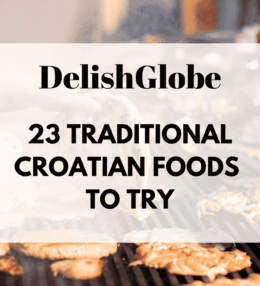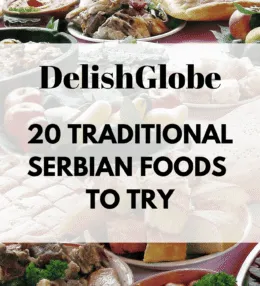Moroccan cuisine is a fascinating blend of history, geography, and culture. Rooted in Berber traditions, it has evolved over centuries, influenced by Arab, Mediterranean, and even French culinary practices.
The result is a cuisine that masterfully balances bold spices like cumin and saffron with the sweetness of dried fruits and honey. From bustling markets to family kitchens, each dish speaks of Morocco’s long-standing trade routes and its diverse cultural exchanges.
As we explore the rich variety of Moroccan dishes, you’ll uncover the heart of the country, a cuisine that’s as complex and varied as the landscapes, from the Atlas Mountains to the Sahara Desert.
Each bite tells a story of the people, their traditions, and the land they call home. Dive in and discover Morocco’s culinary soul.
Loubia (White Bean Stew)
Loubia, the Moroccan white bean stew, is a dish that captures the essence of comfort and simplicity in home cooked meals. Slowly simmered with aromatic spices, tomatoes, and olive oil, Loubia embodies a kind of warmth that feels familiar and nourishing. It’s a staple during the cooler months, offering a satisfying, deeply flavourful experience that draws people together around the table. Get The Recipe Chebakia (Sesame and Honey Pastry)
Chebakia, this golden, honey drenched pastry is intricately shaped, fried to perfection, and coated in fragrant honey, making it a symbol of celebration and togetherness. Often prepared during Ramadan, Chebakia is a treat that brings warmth and sweetness to gatherings, connecting families and friends over its irresistible flavour. Get The Recipe Chicken Tagine (Chicken Stew)
Moroccan Chicken Tagine is a dish that captures the essence of Morocco, vibrant, aromatic, and filled with layers of flavour that tell a story of tradition and warmth. This slow cooked dish, typically prepared in the iconic tagine pot, brings together tender chicken, fragrant spices, and a blend of sweet and savoury elements.Whether you’re savouring it in a bustling Moroccan market or preparing it at home, Chicken Tagine is a journey for the senses, offering an unforgettable taste of Morocco’s rich culinary heritage. Get The Recipe Sardines M’chermel (Spiced Sardines)
Sardines M’chermel is a Moroccan dish that brings the vibrant flavours of the Atlantic coast to the table. This dish features fresh sardines marinated in a bold blend of spices, then either grilled or fried to perfection.Sardines M’chermel embodies the spirit of Moroccan cuisine, simple ingredients, thoughtfully prepared, that result in a dish rich in character and flavour. It’s a favourite among locals and a must-try for anyone looking to experience the authentic tastes of Morocco. Get The Recipe Rfissa Medhoussa (Chicken and Lentil Stew)
Rfissa Medhoussa is a hearty chicken and lentil stew served over a bed of shredded bread, infused with aromatic spices. It’s more than just a meal; it’s a culinary tradition that brings people together, often prepared during special occasions and family gatherings.The comforting flavours, the warmth of spices, and the communal way it’s served make Rfissa Medhoussa a true representation of Morocco‘s hospitality and heritage. Get The Recipe Mrouzia (Sweet Lamb Tagine)
Mrouzia is a dish that expresses the luxurious side of Moroccan cuisine, blending savoury and sweet flavours into a deeply aromatic tagine. Traditionally prepared during special occasions like Eid al-Adha, this sweet lamb tagine is a feast for the senses, featuring tender meat simmered with honey, raisins, and a carefully curated blend of spices. The result is a rich, complex dish that evokes the warmth and celebration of Moroccan hospitality. Get The Recipe Meloui (Rolled Moroccan Pancakes)
Meloui, or rolled Moroccan pancakes, are a staple in Morocco’s breakfast culture. With their crispy edges, soft layers, and golden, buttery texture, Meloui are a comforting way to start the day. These flaky, spiral shaped pancakes are often served with honey or jam, and their subtle flavour makes them an ideal canvas for a variety of accompaniments. Get The Recipe Mechoui (Roasted Lamb)
Mechoui, this succulent slow roasted lamb is a centrepiece at festive gatherings, weddings, and family occasions, symbolising the warmth of Moroccan hospitality. With its tender meat and perfectly crisp exterior, Mechoui is a culinary experience that reflects the essence of Moroccan cooking: simple, flavourful, and crafted with care. Get The Recipe Khobz (Traditional Moroccan Bread)
Khobz is Morocco’s beloved everyday bread, a simple yet essential part of Moroccan cuisine. Known for its round, flat shape and slightly crisp crust, Khobz is a versatile bread, often served alongside tagines, soups, and salads. Its distinctive texture makes it perfect for scooping up stews and dips, creating a culinary experience that marries tradition with practicality. Get The Recipe Kefta (Spiced Meatballs)
Kefta, the Moroccan take on spiced meatballs, is a dish that embodies the bold flavours and fragrant spices that are so integral to Moroccan cooking. These small, tender morsels of seasoned meat are packed with aromatic herbs and spices, then cooked to perfection, often grilled or simmered in a savoury sauce. Get The Recipe Kaab el Ghazal (Gazelle Horns)
Kaab el Ghazal, also known as Gazelle Horns, is one of Morocco‘s most beloved pastries, celebrated for its delicate texture and aromatic filling. These crescent shaped treats, filled with a fragrant almond paste, are not just delicious, they are a symbol of Moroccan hospitality, elegance, and the fine art of pastry making.Whether served at weddings, family gatherings, or during festive occasions, Kaab el Ghazal embodies the grace and beauty of Moroccan culinary tradition. Get The Recipe Harira (Tomato and Lentil Soup)
Harira, this hearty tomato and lentil soup, often enriched with chickpeas, herbs, and tender meat, is a staple of Moroccan cuisine, especially during the holy month of Ramadan. It’s a dish that brings comfort, nourishment, and a sense of togetherness, enjoyed by families at the end of a long day of fasting or during festive occasions. Get The Recipe Ghriba (Almond Cookies)
Ghriba, the beloved Moroccan almond cookie, these cookies are known for their delicate, crumbly texture and distinct cracked surface, making them an irresistible addition to any tea table. Often enjoyed during celebrations or offered as a gesture of welcome, Ghriba embodies the warmth and charm of Moroccan culture in every bite. Get The Recipe Couscous Tfaya (Sweet and Savoury Couscous)
Couscous Tfaya is a dish that perfectly embodies the balance of flavours in Moroccan cuisine, combining sweet and savoury elements into one harmonious dish. Known for its fluffy grains of couscous, caramelized onions, and tender meat, Couscous Tfaya is a true celebration of taste and texture.It’s a meal that’s traditionally enjoyed during festive gatherings, bringing families together around a table filled with warmth and the comforting aromas of spiced, slow-cooked ingredients. Get The Recipe Bissara (Fava Bean Soup)
Bissara, made from fava beans and subtly seasoned, this hearty soup has been a staple of Moroccan households for generations. Whether you’re enjoying it as a simple breakfast on a chilly morning or as a filling dinner after a long day, Bissara brings warmth, nourishment, and a taste of tradition in every spoonful.
Get The Recipe Baghrir (Moroccan Pancakes)
Baghrir, also known as Moroccan pancakes, is a dish that instantly brings a sense of comfort and warmth. These spongy, honeycomb like pancakes are an essential part of Moroccan breakfast and are often shared during family gatherings and festive occasions. With their delicate texture and unique appearance.
Get The Recipe B’stilla (Savoury-Sweet Pie)
Moroccan B’stilla (also spelled pastilla) is a unique and beloved dish in Moroccan cuisine, known for its combination of savoury and sweet flavours. Traditionally made with pigeon, this pie is wrapped in layers of thin, flaky pastry and filled with spiced meat, almonds, and a rich blend of spices. It’s then dusted with powdered sugar and cinnamon, creating a delightful contrast between the sweetness of the topping and the savoury filling inside. Get The Recipe Amlou (Almond, Honey, and Argan Oil Spread)
Amlou is a traditional Moroccan spread made from almonds, honey, and argan oil, often enjoyed as a luxurious addition to bread or pancakes during breakfast. Rich, creamy, and packed with nutrients, it offers a unique combination of flavours, earthy, nutty, sweet, and slightly tangy, thanks to its star ingredient: argan oil. This simple yet decadent spread has become a beloved staple in Moroccan homes, cherished for its flavour and its cultural connection. Get The Recipe 


























